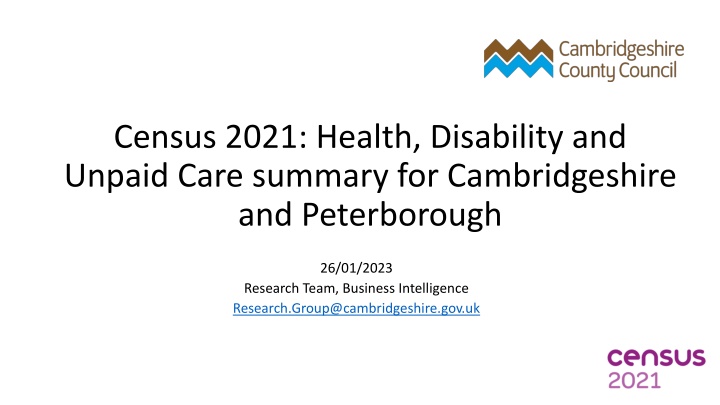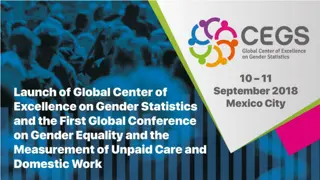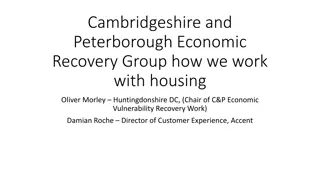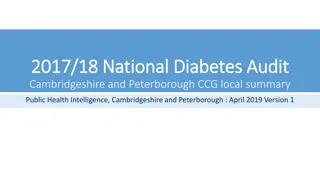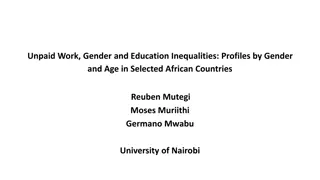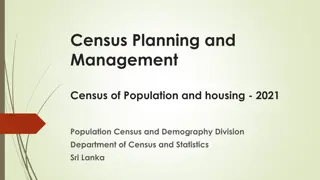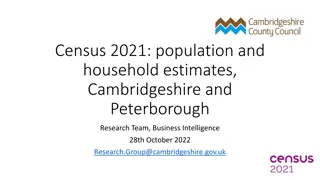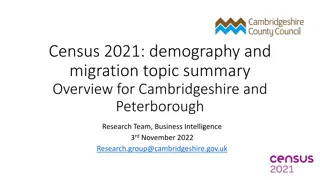Insights from Census 2021: Health, Disability, and Unpaid Care in Cambridgeshire and Peterborough
Explore the key findings from the Census 2021 on general health, disability, and unpaid care in Cambridgeshire and Peterborough. Understand how individuals assess their health, the impact of disabilities on daily activities, and the provision of unpaid care within households. Gain insights into the number of disabled individuals in households and the relationship between age and health outcomes.
Download Presentation

Please find below an Image/Link to download the presentation.
The content on the website is provided AS IS for your information and personal use only. It may not be sold, licensed, or shared on other websites without obtaining consent from the author.If you encounter any issues during the download, it is possible that the publisher has removed the file from their server.
You are allowed to download the files provided on this website for personal or commercial use, subject to the condition that they are used lawfully. All files are the property of their respective owners.
The content on the website is provided AS IS for your information and personal use only. It may not be sold, licensed, or shared on other websites without obtaining consent from the author.
E N D
Presentation Transcript
Census 2021: Health, Disability and Unpaid Care summary for Cambridgeshire and Peterborough 26/01/2023 Research Team, Business Intelligence Research.Group@cambridgeshire.gov.uk
Themes A first overview of some of the local authority level Cambridgeshire and Peterborough data from the Health, Disability and Unpaid Care topic summary published by the Office for National Statistics (ONS) Health, disability, and unpaid care: Census 2021 in England and Wales - Office for National Statistics (ons.gov.uk) By local authority: General health Disability Unpaid care
Definitions General health A person's assessment of the general state of their health from very good to very bad (see categories below). This assessment is not based on a person's health over any specified period of time. Very good health Good health Fair health Bad health Very bad health Disability People who assessed their day-to-day activities as limited by long-term physical or mental health conditions or illnesses are considered disabled (see categories below). This definition of a disabled person meets the harmonised standard for measuring disability and is in line with the Equality Act (2010). Disabled under the Equality Act: Day-to-day activities limited a lot Disabled under the Equality Act: Day-to-day activities limited a little Not disabled under the Equality Act: Has long term physical or mental health condition but day-to-day activities are not limited Not disabled under the Equality Act: No long term physical or mental health conditions
Definitions continued Unpaid care An unpaid carer may look after, give help or support to anyone who has long-term physical or mental ill- health conditions, illness or problems related to old age. This does not include any activities as part of paid employment. This help can be within or outside of the carer's household. Provides no unpaid care Provides 9 hours or less unpaid care a week Provides 10 to 19 hours unpaid care a week Provides 20 to 34 hours unpaid care a week Provides 35 to 49 hours unpaid care a week Provides 50 or more hours unpaid care a week
Definitions continued Number of disabled people in household The number of people in a household who assessed their day-to-day activities as limited by long-term physical or mental health conditions or illnesses and are considered disabled. This definition of a disabled person meets the harmonised standard for measuring disability and is in line with the Equality Act (2010). No people disabled under the Equality Act in household. 1 person disabled under the Equality Act in household. 2 or more people disabled under the Equality Act in household. Does not apply. Age Standardising Health, disability and unpaid care are all closely related to the age of a population. In a more elderly population, you would expect poorer health, more disability and more unpaid care. For example, we know the number of elderly people in the England and Wales population has increased over this period, so a finding of poorer health in 2021 could be directly due to a decline in health, or just reflect that the population has aged. Age-standardised proportions (ASPs) take into consideration both population size and age-structure, to compare like with like. When using ASPs to compare between local authorities, we can say that the higher proportion of disabled people found in Fenland and South Cambridgeshire is due to a difference in prevalence, rather than a difference in the age or size of the population.
Comparability Comparability between 2011 and 2021 censuses It has not been possible to compare age standardised health between 2011 and 2021 because there are no local data for 2011 to compare with 2021 data. Disability cannot accurately be compared between 2011 and 2021 because in 2011 the question focussed on long term disability not disability as a whole therefore the decision was made locally not to compare between the two censuses on this question.
General Health Headlines (Non age standardised Non age standardised) 83.5% of Cambridgeshire and Peterborough residents reported being in good or very good health, above the national average (82.2%), with 4.4% reporting being in bad or very bad health, below the national average (5.2%). There was no notable change between 2011 and 2021. In Cambridgeshire there was a 0.1% decrease from 2011, in Peterborough there was a 0.4% increase in self reported good or very good health. The biggest change in good or very good health between 2011 and 2021 occurred in Huntingdonshire with a reduction of 0.9% from 84.4% to 83.6% (rounded) in good or very good health. The biggest change in bad or very bad health between 2011 and 2021 occurred in Cambridge with a reduction of 0.4% from 3.6% to 3.2%.
General Health (non age standardised standardised) comparison 2011- 2021 comparison % non age Cambridgeshire and Peterborough 2011 Cambridgeshire and Peterborough 2021 East of England 2021 Cambridgeshire 2011 Cambridgeshire 2021 Peterborough 2011 Peterborough 2021 East of England 2011 Health England 2011England 2021 48.2% 48.6% 49.4% 49.4% 44.3% 46.2% 47.2% 48.5% 47.2% 48.3% Very good health 388,185 434,648 306,910 335,098 81,275 99,550 25,005,712 27,390,829 2,761,271 3,058,673 35.3% 34.9% 34.7% 34.6% 37.3% 35.9% 34.2% 33.7% 35.2% 34.6% Good health 284,239 312,492 215,746 235,114 68,493 77378 18,141,457 19,040,735 2,060,157 2,194,562 12.1% 12.1% 11.8% 11.9% 13.3% 12.9% 13.1% 12.7% 12.9% 12.5% Fair health 97,748 108,267 73,386 80,537 24,362 27,730 6,954,092 7,147,346 752,324 791,639 3.4% 3.4% 3.2% 3.2% 4.0% 4.0% 4.2% 4.0% 3.6% 3.6% Bad health 27,140 30,618 19,715 22,036 7,425 8,582 2,250,446 2,248,255 212,830 226,719 0.9% 0.9% 0.9% 0.9% 1.1% 1.1% 1.2% 1.2% 1.0% 1.0% Very bad health 7,529 8,497 5,453 6,064 2,076 2,433 660,749 662,881 60,383 63,479
General Health by district (Non age standardised Non age standardised) % East East South South Cambridge 2011 Cambridge 2021 Cambridgeshire 2011 Cambridgeshire 2021 Fenland 2011 Fenland 2021 Huntingdonshire 2011 Huntingdonshire 2021 Peterborough 2011 Peterborough 2021 Cambridgeshire 2011 Cambridgeshire 2021 Health Very good health 54.7% 55.1% 48.8% 48.3% 39.4% 40.3% 48.8% 47.9% 44.3% 46.2% 52.5% 52.2% Good health 32.0% 32.1% 35.2% 35.1% 37.8% 37.5% 35.7% 35.7% 37.3% 35.9% 33.7% 33.6% Fair health 9.7% 9.6% 12.1% 12.4% 16.5% 15.9% 11.6% 12.2% 13.3% 12.9% 10.6% 10.7% Bad health 2.9% 2.6% 3.1% 3.3% 4.8% 4.9% 3.1% 3.4% 4.0% 4.0% 2.5% 2.7% Very bad health 0.8% 0.7% 0.8% 0.9% 1.4% 1.4% 0.9% 0.9% 1.1% 1.1% 0.7% 0.8%
General Health (non age standardised standardised): Good or Very Good 2011 2021, % of population non age The lowest levels of good and very good health remain in Fenland despite a 0.5% increase from 2011 to 2021 Cambridge remains the area with the highest level of good or very good health and also saw a 0.5% increase. Nowhere had a higher proportional increase than experienced in England. Locally, Huntingdonshire saw the largest fall of 0.8% in good or very good health.
General Health (non age standardised standardised): Bad or Very Bad 2011 2021, % of population non age Fenland remained the area with the highest level of bad or very bad health reported rising from 6.2% to 6.4%. Cambridge is now the area with the lowest proportion of reported bad or very bad health falling from 3.6% to 3.2%. Peterborough was the only other area to see a small reduction in reported bad or very bad health from 5.2% to 5.1%.
General Health (Age Standardised Standardised) Headlines Age Good or very good health is reported most highly in South Cambridgeshire (85.9%) and East Cambridgeshire (84%), this is higher than England (81.7%) and the East of England (82.9%). The lowest level of good or very good health is reported in Fenland (79%) and Peterborough (79.3%). Bad or very bad health is highest at 6% in both Fenland and Peterborough. This is higher than England 5.3% and the East of England 4.6%. Bad or very bad health is lowest in South Cambridgeshire (3.4%) and East Cambridgeshire (3.9%).
General Health Age Standardised Standardised Age
Unpaid Care Headlines (Non age standardised) (Non age standardised) Number and proportion of residents providing no unpaid care has risen from 2011 to 2021 across all areas of Cambridgeshire and Peterborough. Breakdown of those providing unpaid care shows an unexpected increase in number of residents providing more hours of care in 2021 than in 2011. These trends are seen in the East of England and nationally. South Cambrid geshire 2011 South Cambridg eshire 2021 East East Cambridge 2011 Cambridge 2021 Cambridge shire 2011 Cambridge shire 2021 Fenland 2011 Fenland 2021 Huntingdon shire 2011 Huntingdon shire 2021 Peterborough 2011 Peterborough 2021 Cambridge shire 2011 Cambridge shire 2021 Unpaid Care Provides No unpaid care 92.1% 93.7% 90.1% 91.4% 88.9% 90.4% 90.3% 91.7% 90.4% 91.9% 89.9% 91.6% 90.3% 91.9% Provides 1 to 19 hours unpaid care a week 5.8% 3.7% 6.8% 4.9% 6.5% 4.2% 6.6% 4.5% 5.8% 3.6% 7.5% 5.1% 6.7% 4.5% Provides 20 to 49 hours unpaid care a week 0.8% 1.1% 1.1% 1.4% 1.6% 2.1% 1.1% 1.4% 1.4% 1.9% 0.9% 1.3% 1.1% 1.4% Provides 50 or more hours unpaid care a week 1.3% 1.5% 2.0% 2.3% 3.1% 3.4% 2.0% 2.4% 2.4% 2.5% 1.6% 2.0% 1.9% 2.2%
Unpaid Care (Non age standardised) number of hours table South Cambridg eshire 2011 East East South Cambridge shire 2021 Cambridge 2011 Cambridge 2021 Cambridge shire 2011 Cambridgeshire 2021 Fenland 2011 Fenland 2021 Huntingdon shire 2011 Huntingdon shire 2021 Peterborough 2011 Peterborough 2021 Cambridge shire 2011 Cambridge shire 2021 Unpaid Care Provides No Unpaid Care 114090 130613 75529 76067 84668 87974 152983 157021 165941 185265 133764 140468 561034 592143 Provides 1 to 19 hours unpaid care a week 7146 5151 5725 4079 6154 4046 11150 7645 10732 7313 11138 7869 41313 28790 Provides 20 to 49 hours unpaid care a week 1042 1523 927 1185 1496 1998 1911 2466 2616 3853 1409 1998 6785 9170 Provides 50 or more hours unpaid care a week 1589 2040 1637 1912 2944 3272 3464 4040 4342 5078 2444 3012 12078 14276
% of Residents that provide no Unpaid Care 2011-2021 All areas have a higher proportion of residents not providing any unpaid care. Cambridgeshire and Peterborough (91.9%) are higher than the East of England (91.4%) and England (91.2%). Cambridge (93.7%) has the highest level of residents providing no unpaid care, above the Cambridgeshire average of 91.9%. Fenland (90.4%) has the lowest.
Of those that provide unpaid care: All areas have seen the distribution of unpaid care skew toward a higher number of hours of unpaid care being provided from 2011 to 2021. Peterborough (55%) and Fenland (56%) are the two areas with the highest proportions of residents providing more than 20 hours of unpaid care per week.
Unpaid Care: distribution skew The previous slides showed that among residents that provide unpaid care, there has been an unexpected proportional distribution shift between 2011 and 2021 away from lower numbers of hours to higher numbers of hours being provided. The following points could explain why this has happened; coronavirus guidance on reducing travel and limiting visits to people from other households unpaid carers who previously shared caring responsibilities may have taken on all aspects of unpaid care because of rules on household mixing during the coronavirus pandemic there were a higher number of deaths than expected in the older population at the beginning of 2021 due to coronavirus (COVID-19) and other causes; this could have led to a reduction in the need for unpaid care changes in the question wording between 2011 and 2021 may have had an impact on the number of people who self-reported as unpaid carers Unpaid care, England and Wales - Office for National Statistics (ons.gov.uk)
Unpaid care hours: question change between 2011 - 2021 Note: Census 2021 asked "Do you look after, or give any help or support to, anyone because they have long-term physical or mental health conditions or illnesses, or problems related to old age?". People were asked to exclude anything they did as part of their paid employment. The wording of the question differs from the 2011 Census question, which began "Do you look after, or give any help or support to family members, friends, neighbours or others". Unpaid care, England and Wales - Office for National Statistics (ons.gov.uk)
Disability Comparability: To identify disability in England and Wales, the Census asked people "Do you have any physical or mental health conditions or illnesses lasting or expected to last 12 months or more?". If they answered yes, a further question "Do any of your conditions or illnesses reduce your ability to carry out day-to-day activities?" was presented. The identification of disability differs from the 2011 Census question used, which asked "Are your day-to-day activities limited because of a health problem or disability which has lasted, or expected to last, at least 12 months? . The question changed in order to collect data that more closely aligned with the definition of disability in the Equality Act (2010). The Equality Act defines an individual as disabled if they have a physical or mental impairment that has a substantial and long-term negative effect on their ability to carry out normal day-to-day activities. The way we identify disabled people has therefore changed between 2011 and 2021 and this may have had an impact on the number of people identified as disabled. See Section 8: Measuring the data for more information on the question change. For this reason, this local summary has not compared the 2021 results to the 2011 results.
National headline In England, the proportion of disabled people (age standardised*) decreased between censuses (from 19.3% in 2011 to 17.7% in 2021). However, there was an increase in the number of disabled people (from 9.4 million in 2011 to 9.8 million in 2021). Note: The ONS produced national age standardised findings for the 2011 and 2021 census but there are no local age standardised findings for 2011 so we are not able to compare age standardised disability between censuses from this initial data release. The following data is not age standardised unless marked. *Disability and age are closely related, with older people being more likely to be disabled. Age-standardised proportions (ASPs) account for different age structures in populations and are more appropriate than crude percentages when drawing comparisons over time and across areas
Upper tier headlines Cambridgeshire and Peterborough have lower percentages of residents reporting as Disabled under the Equality Act against the East of England and England. Cambridgeshire has a higher proportion of residents reporting as not disabled but with a long term physical or mental health condition but day to day activities are not limited (8%) than Peterborough (5.8%), East of England (7.2%) and England (6.8%). Cambridgeshire and Peterborough number Cambridgeshire and Peterborough % Cambridgeshire number Cambridgeshire % Peterborough number Peterborough % East % England % Disability Total: All usual residents 678,849 100.0 215,673 100.0 100.0 100.0 894,522 100 Disabled under the Equality Act Disabled under the Equality Act: Day-to-day activities limited a lot Disabled under the Equality Act: Day-to-day activities limited a little 109,908 16.2 35,180 16.3 16.6 17.3 145,088 16.2% 40,853 6.0 14,875 6.9 6.6 7.3 55,728 6.2% 69,055 10.2 20,305 9.4 10.0 10.0 89,360 10.0% Not disabled under the Equality Act 568,941 83.8 180,493 83.7 83.4 82.7 749,434 83.8% Not disabled under the Equality Act: Has long term physical or mental health condition but day-to-day activities are not limited Not disabled under the Equality Act: No long term physical or mental health conditions 54,457 8.0 12,609 5.8 7.2 6.8 67,066 7.5% 514,484 75.8 167,884 77.8 76.1 75.9 682,368 76.3%
District breakdown Fenland has the highest proportion with 20.3% of residents reporting as disabled under the Equality Act, and it is the only district which is higher than the East of England and England averages.Cambridge and South Cambridgeshire have the lowest proportion with 14.7%. Peterborough has the highest number of residents reporting as disabled with 35,180. East Cambridgeshire has the lowest number of residents reporting as disabled with 14,166. East East Huntingdon shire number South South Cambridge shire % Cambridge number Cambridge % Fenland number Fenland % Huntingdon shire % Peterborough number Peterborough % Cambridgeshire number Cambridgeshire % Cambridgesh ire number Disability Total: All usual residents 145,674 100.0 87,762 100.0 102,462 100.0 180,832 100.0 215,673 100.0 162,121 100.0 Disabled under the Equality Act Disabled under the Equality Act: Day-to-day activities limited a lot Disabled under the Equality Act: Day-to-day activities limited a little 21,433 14.7 14,166 16.1 20,836 20.3 29,577 16.4 35,180 16.3 23,898 14.7 7,162 4.9 5,227 6.0 9,046 8.8 11,048 6.1 14,875 6.9 8,370 5.2 14,271 9.8 8,939 10.2 11,790 11.5 18,529 10.2 20,305 9.4 15,528 9.6 Not disabled under the Equality Act 124,241 85.3 73,596 83.9 81,626 79.7 151,255 83.6 180,493 83.7 138,223 85.3 Not disabled under the Equality Act: Has long term physical or mental health condition but day-to-day activities are not limited 11,269 7.7 7,375 8.4 7,186 7.0 14,805 8.2 12,609 5.8 13,822 8.5 Not disabled under the Equality Act: No long term physical or mental health conditions 112,972 77.6 66,221 75.5 74,440 72.7 136,450 75.5 167,884 77.8 124,401 76.7
Disabled under the Equality Act: day to day activities limited a little / a lot % Fenland has the highest proportion of residents reporting as being disabled. It also has the highest proportions in both day to day activities limited a lot and day to day activities limited a little .
Of those with a disability 37% of disabled Cambridgeshire residents have their activities limited a lot. Fenland has the largest proportion of its disabled population reporting that their activities are limited a lot.
Not disabled under the Equality Act: Has long term physical or mental health condition but day-to-day activities are not limited % There are those that are not disabled under the Equality Act definition but have long term physical or mental health conditions that do not affect their day to day activities. South Cambridgeshire (8.5%) and East Cambridgeshire (8.4%) have the highest proportion of residents that are not disabled but have a long term physical or mental health condition. Peterborough with 5.8% has the lowest.
Disability Headlines (Age Standardised Standardised) In Cambridgeshire, 16.4% of residents report as being disabled, this is lower than East of England (16.6%) and England (17.7%). South Cambridgeshire has the lowest proportion of residents reporting as disabled with 14.8%. East Cambridgeshire (15.9%) also has a lower proportion than the East of England and England. Huntingdonshire (16.7%), Peterborough (18.3%) and Fenland (19.6%) have a higher proportion than the East of England and England. Age Disabled under the Equality Act: Day-to-day activities limited a little 11.2 10.4 10.2 10.5 10.0 10.3 10.2 10.1 9.7 Disability Disabled under the Equality Act: Day-to-day activities limited a lot 8.4 7.9 7.5 6.2 6.6 6.1 6.1 5.8 5.1 Not disabled under the Equality Act 80.5 81.7 82.3 83.3 83.4 83.6 83.7 84.1 85.2 Fenland Peterborough England Cambridge East of England Cambridgeshire Huntingdonshire East Cambridgeshire South Cambridgeshire
Disability (Age Standardised Age Standardised) %
Number of Disabled People in a Household No people disabled under the Equality Act in household No people disabled under the Equality Act in household 1 person disabled under the Equality Act in household 1 person disabled under the Equality Act in household 2 or more people disabled under the Equality Act in household 2 or more people disabled under the Equality Act in household Total: All households Total: All households Disabled people in the household number % number % number % number % Area Fenland England Peterborough East Cambridgeshire and Peterborough Cambridgeshire East Cambridgeshire Huntingdonshire South Cambridgeshire Cambridge 44,083 100.0 100.0 100.0 100.0 100.0 100.0 100.0 100.0 100.0 100.0 28,361 64.3 68.0 68.4 69.1 69.6 69.9 70.1 70.2 71.7 71.8 12,155 5,950,081 20,888 644,288 6,594,369 66,561 8,852 18,294 15,367 11,893 27.6 25.4 24.7 24.5 24.1 24.0 23.8 23.8 22.9 22.7 3,567 8.1 6.6 6.9 6.4 6.3 6.1 6.1 6.0 5.3 5.6 23,436,085 84,533 2,628,782 26,064,867 277,634 37,203 76,880 66,996 52,472 15,928,198 57,836 1,816,840 17,745,038 194,134 26,086 53,965 48,056 37,666 1,557,806 5,809 167,654 1,725,460 16,939 2,265 4,621 3,573 2,913 Cambridgeshire (30.1%) and Peterborough (31.6%) have a lower proportion of households with a disabled person resident than nationally (32%). Fenland (35.7%) has the highest percentage of homes with at least one disabled person resident and is the only area higher than England.
Number of disabled people in households Fenland has the highest proportion of homes with at least 1 disabled person resident (35.7%). Fenland is the only area with a higher proportion than England.
Households with a disabled person breakdown Majority of disabled people live in households where they are the only disabled person under the equality act. Fenland (23%) has the highest proportion of households with 2 or more disabled people. South Cambridgeshire (19%) has the lowest proportion.
Census 2021: useful links Census 2021 Cambridgeshire Insight Population Census 2021 webpages on Cambridgeshire Insight, including: Census 2021 first results: published report, recorded presentation and dataset, Census 2021 topic summaries: Cambridgeshire and Peterborough summaries and further resources available Cambs Insight tools already have demography and migration datasets, and they will be updated with the release of each topic summary: Map explorer Data explorer Census 2021 data published on the ONS website and on NOMIS ONS tools: Census maps Area profiles available on NOMIS at local authority level. How your area has changed in 10 years: Census 2021
